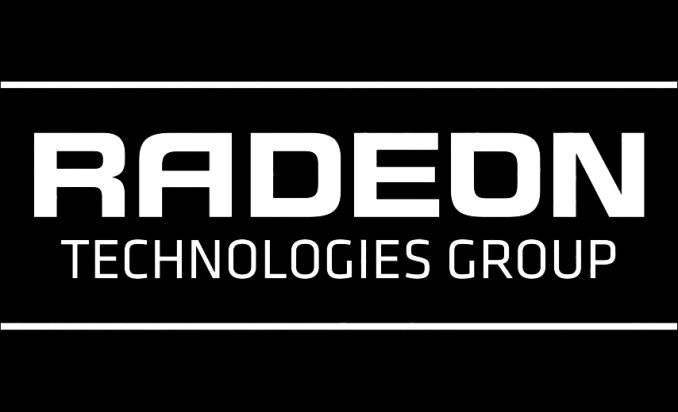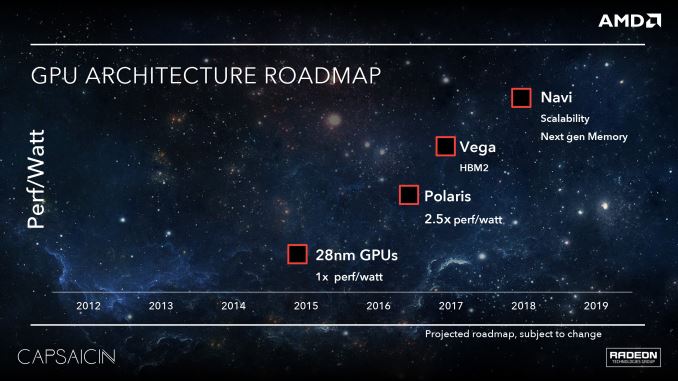AMD Unveils GPU Architecture Roadmap: After Polaris Comes Vega
by Ryan Smith on March 15, 2016 3:30 AM EST
Although AMD’s GDC 2016 “Capsaicin” event was primarily focused on game development – it is the Game Developers Conference, after all – AMD did spend a brief moment discussing their future GPU plans. For the first time in many years, AMD has published a GPU architecture roadmap.
Plotting perf/watt against the years, AMD’s roadmap unveils two new architectures: Vega, and Navi. Essentially everything there is to know about these architectures is in this slide – AMD is being tight-lipped regarding further details – but this map gives us some tantalizing new information to work with.
Vega is currently scheduled to come relatively quickly after Polaris. Depending on how literal you interpret this chart, the far left edge of the Vega box does fall into 2016, though obviously AMD intends to leave themselves some wiggle room here and not tie themselves down to specific dates. The fact that Vega comes this soon after Polaris is interesting; it seems hard to believe that it’s a direct successor to Polaris – I can’t see AMD replacing Polaris parts in less than a year – so this points to Vega being more of a cousin, and is where AMD’s naming system isn’t especially helpful in deciphering anything further.
With Polaris confirmed to use GDDR5, Vega is notable for being the first AMD architecture to use HBM2, and the first parts in general to use HBM tech since Fiji. I’m presuming these are higher-end GPUs to complement the Polaris GPUs (the smaller of which we know to be a low-power laptop design), which is where HBM would be more cost-effective, at least at current prices.
Meanwhile AMD has also confirmed the number of GPUs in the Vega stack and their names. We’ll be seeing a Vega 10 and a Vega 11. This follows Polaris GPU naming – which has finally been confirmed – with Polaris 10 and Polaris 11. I have also been told that Polaris 11 is the smaller of the Polaris GPUs, so at this point it’s reasonable to assume the same for Vega.
Finally, farther out towards 2018 is an architecture AMD is calling Navi. This one I suspect will attract the most attention (even if it’s the farthest out) due to the ambiguity of its features: “scalability” and “next gen memory”. Similar to how it’s hard to see Vega directly replacing Polaris, it’s hard to see Navi directly replacing Vega after only a year. This leaves Navi rife for speculation; I could very well see it being a Polaris replacement since we’ll be nearly 2 years past Polaris, or perhaps something to do with AMD’s APU plans. Either way I don’t expect that this will be the last time AMD teases it before finally launching it.

















54 Comments
View All Comments
nevcairiel - Tuesday, March 15, 2016 - link
GDDR5X is at least somwhat competitive to HBM1, ~448GB/s vs 512GB/s, of course HBM2 doubles that again.If they remain limited to 4GB on HBM1, one can certainly hope AMD pushes for a (at least close to high-end) with GDDR5X, as 4GB just doesn't cut it for a 2016 GPU.
Despoiler - Tuesday, March 15, 2016 - link
Bandwidth wasn't the primary reason HBM was conceived. It's power budget. 5X at it's lowest voltage uses 15% more power than HBM. It also can only scale up 2 voltage tiers. Obviously those will make it look worst in terms of power budget vs HBM.ImSpartacus - Tuesday, March 15, 2016 - link
That's likely. We've already heard rumors of Greenland being renamed Vega 10. Now that we know the "10" gpu is the beefiest, it makes sense.Qwertilot - Tuesday, March 15, 2016 - link
Looks absolutely sane. They very badly need competitive mobile (and low/mid end) GPU's. If they get this release right these will serve as that for much of the duration of 14/16nm.Worth remembering that claimed power efficiency gain - 2.5 times. Even if its 'only' ~2x, in practice they should be able to cover the high end quite well at ~150w until really big 14/16nm stuff rolls up.
prtskg - Wednesday, March 16, 2016 - link
Wasn't the claimed efficiency 2X but it was w.r.t. nano (As we saw in testing). W.r.t. other GCN gpus efficiency improvement is 2.5X.r3loaded - Tuesday, March 15, 2016 - link
Ugh c'mon, not another product naming scheme! I was just getting comfortable with R9 2XX and R9 3XX.Arnulf - Tuesday, March 15, 2016 - link
Don't worry, these are just codenames like the star names of Phenom/Phenom II era. End customers will be buying 4xx, 5xx etc. series cards and not Polaris, Vega etc., just like they bought Phenom, Phenom II or Athlon II rather than Toliman, Deneb, Regor CPUs ...SaberKOG91 - Tuesday, March 15, 2016 - link
Agreed. Polaris 10 seems to be performance optimized, while Polaris 11 is power optimized. Very much like the Fury X and Fury Nano, respectively.Arnulf - Tuesday, March 15, 2016 - link
Wouldn't really surprise me if AMD picked this naming scheme to mess with Nvidia ... e.g. Polaris vs. Pascal, Vega vs. Volta, Navi vs. Newton ...Ammaross - Tuesday, March 15, 2016 - link
+1 point for you sir!